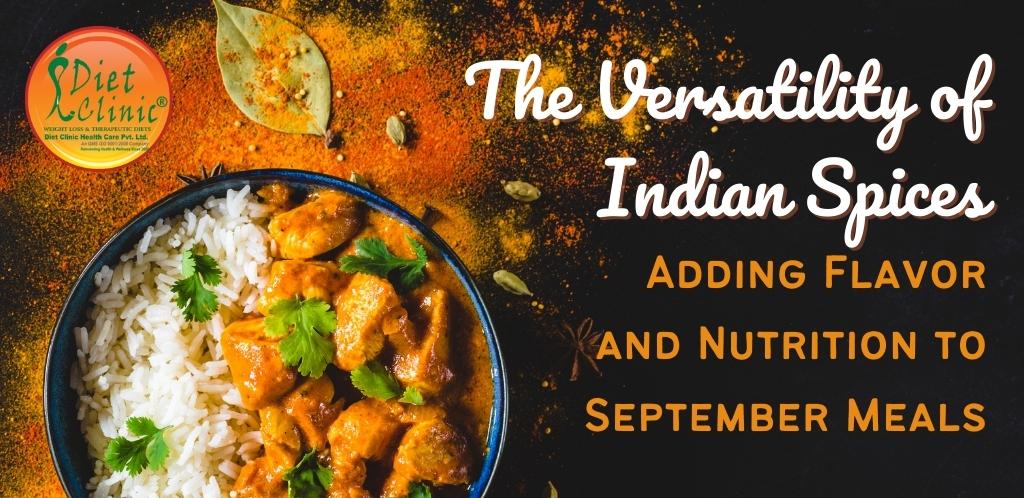
Dietician Sheela Seharawat
The Versatility of Indian Spices: Adding Flavor and Nutrition to September Meals
As September unfolds and the summer heat begins to wane, our culinary preferences often shift towards heartier, warming dishes. It's a season when the kitchen becomes a place of comfort, creativity, and flavor exploration. One of the most delightful aspects of Indian cuisine is its rich and diverse use of spices. These aromatic and flavorful ingredients not only enhance the taste of your meals but also offer numerous health benefits. As a dedicated dietician, I'm excited to delve into the world of Indian spices and show you how to infuse your September meals with flavor and nutrition.
Indian spices are not merely culinary agents; they are also potent sources of essential nutrients, antioxidants, and medicinal properties. By incorporating them into your meals, you can transform ordinary dishes into extraordinary, healthful feasts.
The Health Benefits of Indian Spices
Before we dive into the versatility of Indian spices, let's explore the health benefits they offer:
- Antioxidant Power: Many Indian spices, such as turmeric, cinnamon, and cloves, are rich in antioxidants that combat oxidative stress and inflammation in the body.
- Digestive Aid: Spices like ginger, cumin, and fennel promote healthy digestion, alleviate bloating, and reduce indigestion.
- Metabolic Boosters: Some spices, such as black pepper and mustard seeds, can help rev up your metabolism, aiding in weight management.
- Anti-Inflammatory Properties: Turmeric, with its active compound curcumin, is known for its potent anti-inflammatory effects, which can help alleviate conditions like arthritis.
- Heart Health: Spices like cinnamon may help lower blood pressure and improve heart health by reducing cholesterol levels.
- Blood Sugar Control: Fenugreek seeds and cinnamon have shown promise in helping regulate blood sugar levels, which is particularly beneficial for individuals with diabetes.
Now, let's explore the versatility of Indian spices and how to use them to add flavor and nutrition to your
September meals:
- Turmeric (Haldi): This golden spice is a powerhouse of health benefits. It adds earthy and slightly bitter notes to your dishes. Use it in curries, soups, and stews to infuse a warm and vibrant color.
- Cumin (Jeera): Cumin seeds have a warm, nutty flavor that complements a wide range of dishes. Toast them in oil or ghee to release their full aroma before adding them to your cooking.
- Coriander (Dhania): Coriander seeds and fresh cilantro leaves are both used in Indian cuisine. The seeds have a citrusy, slightly sweet flavor and are often used in spice blends like garam masala.
- Cardamom (Elaichi): Cardamom is known for its sweet, floral aroma. It's commonly used in desserts like kheer (rice pudding) and in spice blends. You can also add it to your morning coffee or tea for a delightful twist.
- Cinnamon (Dalchini): Cinnamon imparts a warm and sweet flavor. It's excellent in both sweet and savory dishes. Add a cinnamon stick to your morning oatmeal or sprinkle ground cinnamon on roasted vegetables.
- Ginger (Adrak): Fresh ginger adds a zesty and slightly spicy kick to your dishes. It's a versatile spice that can be used in stir-fries, marinades, and even desserts like gingerbread.
- Cloves (Laung): Cloves have a strong, pungent flavor and are often used to add depth to dishes like biryani. They're also used in spiced teas and desserts.
- Fenugreek (Methi): Fenugreek seeds have a slightly bitter taste and are often used in pickles and spice blends. The leaves of the fenugreek plant, known as methi leaves, are used in a variety of Indian dishes.
- Mustard Seeds (Rai): Mustard seeds come in various colors, including yellow, brown, and black. They have a sharp and tangy flavor and are often used in tempering or tadka.
- Chilies (Mirch): Indian cuisine features a variety of chilies, from mild to fiery hot. Green chilies, dried red chilies, and chili powder are commonly used to add heat and flavor to dishes.
- Asafoetida (Hing): Asafoetida has a pungent and sulfuric aroma. It's used sparingly, often in vegetarian dishes, to enhance flavor and aid in digestion.
- Curry Leaves (Kadi Patta): Curry leaves add a distinct, aromatic flavor to South Indian dishes. They're commonly used in tempering and chutneys.
How to Incorporate Indian Spices into Your September Meals
Now that we've explored the versatility of Indian spices, let's discuss how to incorporate them into your September meals:
- Curries: Indian curries are a fantastic canvas for a variety of spices. Use a blend of cumin, coriander, turmeric, and garam masala to create rich and flavorful sauces for vegetables, meats, or legumes.
- Rice Dishes: Add spices like cloves, cinnamon, and cardamom to your rice as it cooks. This infuses the rice with a delightful aroma and flavor.
- Stews and Soups: Enhance the flavor of your stews and soups by adding spices like ginger, garlic, and turmeric. They not only impart flavor but also offer immune-boosting properties.
- Roasted Vegetables: Toss your favorite vegetables in a mix of olive oil, cumin, coriander, and paprika before roasting. The spices will elevate the dish and give it a warm, smoky flavor.
- Baking: Don't hesitate to add spices to your baking recipes. Cinnamon, cardamom, and cloves can transform ordinary muffins, cookies, and cakes into aromatic delights.
- Beverages: Spice up your beverages by adding cinnamon to your coffee or chai tea. Ginger can add warmth to your morning smoothie or a soothing element to herbal teas.
- Marinades: Create flavorful marinades for meats and tofu using a combination of spices, garlic, ginger, yogurt, and lemon juice.
- Salad Dressings: Add a pinch of cumin, coriander, or black pepper to your salad dressings for a unique twist on familiar flavors.
- Snacks: Roasted chickpeas or nuts can be spiced up with a sprinkle of garam masala or curry powder for a savory snack.
- Desserts: Explore the sweet side of Indian spices by adding cardamom to your rice pudding, nutmeg to your apple pie, or saffron to your custard.
The versatility of Indian spices knows no bounds, and their use in September meals can elevate your culinary experience while enhancing your health. By incorporating these aromatic and flavorful ingredients into your cooking, you'll not only enjoy delicious meals but also tap into their remarkable health benefits. Whether you're simmering a comforting curry, roasting seasonal vegetables, or brewing a spiced tea, Indian spices offer endless possibilities to infuse flavor and nutrition into your September culinary adventures.










